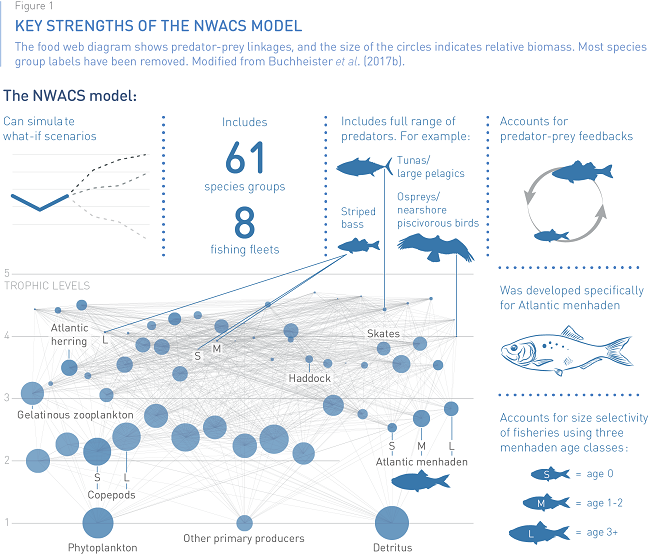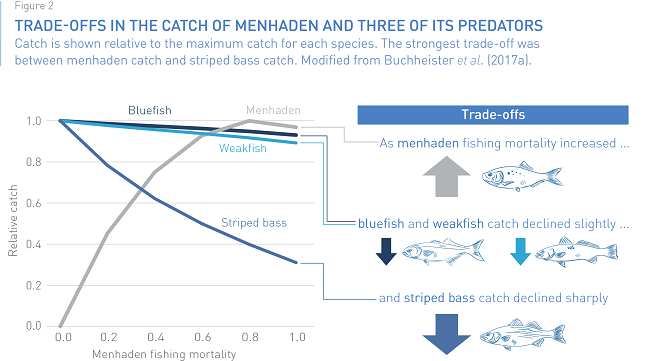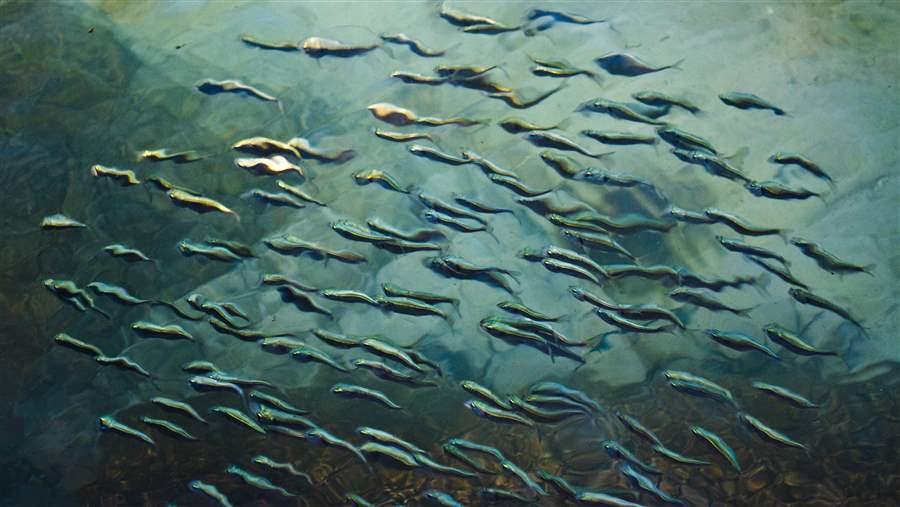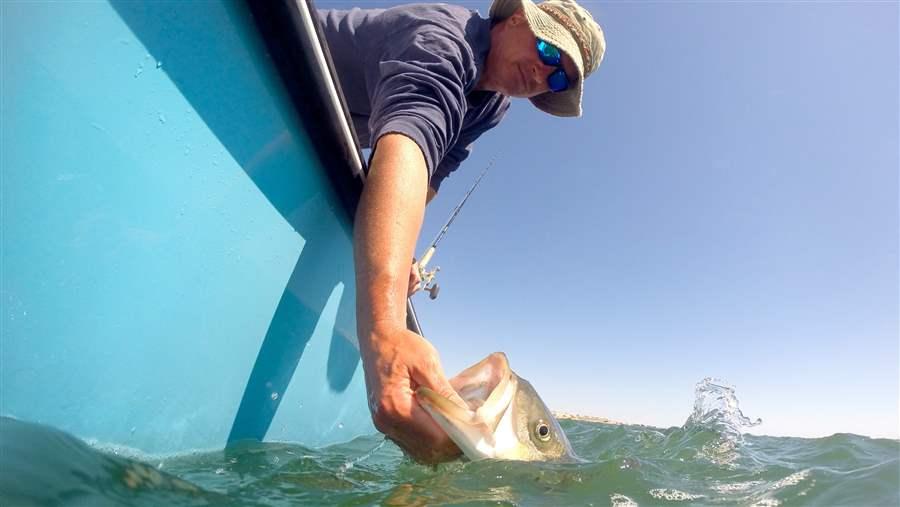A New Tool to Evaluate Management Options for Atlantic Menhaden
Model can explore system-wide tradeoffs
Scientists have completed a new model to more fully explore options for managing Atlantic menhaden, the largest fishery on the East Coast. The model’s main strength is its ability to quantify trade-offs, such as the trade-off between harvesting menhaden and leaving it in the water as food for predators. It was built specifically for menhaden and is the only tool available to evaluate trade-offs across all species in the ecosystem.
Background: Current menhaden management
The current guidelines for menhaden management are focused largely on the target species, and thus they may not leave enough menhaden for important ecological functions, such as providing food for predators. To address this, managers envision a shift to new guidelines that include ecological reference points (ERPs). ERPs are benchmark levels of key metrics (e.g., fishing pressure or species abundance), set with the purpose of maintaining critical ecological functions.
To develop ERPs, the Atlantic States Marine Fisheries Commission (ASMFC) created a working group on Biological and Ecological Reference Points (BERP). This group is developing several multispecies models that include menhaden and a few major finfish predators.
Ecosystem models, by contrast, can include most or all species in the system, as well as the web of interactions among them. They are more complex than single-species or multispecies models, but their advantage is that they can simulate the effects of different management actions on the whole system, accounting for predator-prey feedbacks not captured by most other models.
Methods: The new ecosystem model
In a 2017 paper published in the journal Marine and Coastal Fisheries (Buchheister et al. 2017a), researchers describe a new ecosystem model called NWACS (for northwest Atlantic continental shelf). Created using Ecopath with Ecosim (EwE) software, it incorporates eight fishing fleets and 61 trophic groups (i.e., species or groups of species), including all major predators on menhaden. To account for the fact that fisheries and predators vary in the ages of menhaden they take, the NWACS models menhaden, striped bass, bluefish, and weakfish in three age classes.
The framework of the model is a food web (see Figure 1), which shows what each species eats. After building this framework, the researchers adjusted model inputs—such as growth rates, feeding rates, and diet compositions—to get the best fit with real-world data. The resulting model provides a picture of how biomass flows through the system, from plankton at the base of the food web up through top predators.

The model is highly interconnected, with a total of 989 predator-prey links. Menhaden proved to be an important prey species: 22 predators consumed it, and it made up 30 percent of the diet of large striped bass (age 7 years and older) and 33 percent of the diet of nearshore piscivorous birds (such as cormorants and ospreys).
The outputs of the model match most of the patterns observed in 67 historical data sets. These data came from stock assessments, surveys, and the scientific literature. They covered fisheries catch and biomass for key species from 1982 to 2013.
Exploring trade-offs
As a first step in the process of exploring trade-offs in menhaden management, the researchers projected how various levels of menhaden fishing would affect the biomass of all groups in the model and the catch of fished species. These levels included the fishing mortality that produces maximum sustainable yield (FMSY), 50 percent of FMSY, and the current benchmark levels for menhaden fishing mortality (known as F reference points*).
The projections resulted in quantitative estimates of several trade-offs. One of the strongest trade-offs was between the catch of menhaden and the catch of striped bass. As simulated menhaden fishing increased from zero to FMSY (F=0.8), the catch of striped bass declined by 60 percent. Figure 2 shows this trade-off in detail, along with the much less pronounced trade-offs between menhaden and both bluefish and weakfish. Nearshore piscivorous birds and tunas were among the other groups showing strong trade-offs with menhaden, although the uncertainty of these findings is relatively high.
It should be noted that the current target level for fishing mortality of menhaden in the NWACS model (F=0.29) is well below FMSY. According to the model, if fishermen caught this target level over the long term, striped bass catch would be 29 percent lower than it would be with no menhaden fishing.

Future uses of the model
The NWACS model is available for decision-makers, experts, and stakeholders interested in further exploration. It can be used to test out a much wider range of “what-if” scenarios and management strategies than those described here.
Such strategies could include reference points that use metrics other than fishing mortality. For example, managers could explore the effects of reference points based on the abundance of key predators. Or they could explore the effect on predators of setting a minimum level of landings to sustain the fishery. Whatever the choice, it is important to test the likely outcomes of any strategy before implementing it.
Another benefit of the EwE modeling framework is that, because it includes the full system, it allows for comparisons across models that include different subsets of the system. Such comparisons can help in evaluating uncertainty and testing the robustness of conclusions.
NWACS can also be used to forecast the effects of ocean warming or other environmental changes that may alter the productivity of certain species, an outcome that some studies have said is likely.
The model is primarily intended to inform long-term, strategic decisions based on broad-scale directions and patterns of change. This makes it a valuable complement to single-species and multispecies models.
NWACS is the first model of its kind that is specific to Atlantic menhaden, and it comes as managers are considering how to best to transition from a single-species approach to one that accounts for the role of menhaden as prey.
Citation
Buchheister, A., Miller, T. J., Houde, E. D. (2017a). Evaluating ecosystem-based reference points for Atlantic menhaden (Brevoortia tyrannus). Marine and Coastal Fisheries. doi: 10.1080/19425120.2017.1360420.
Buchheister, A., Miller, T. J., Houde, E. D., and Loewensteiner, D. A. (2017b). Technical Documentation of the Northwest Atlantic Continental Shelf (NWACS) Ecosystem Model. Report to the Lenfest Ocean Program, Washington, D.C. University of Maryland Center for Environmental Sciences Report TS-694-17. Available at: http://hjort.cbl.umces.edu/NWACS/TS_694_17_NWACS_Model_Documentation.pdf.
*NOTE: PROXY REFERENCE POINTS
The NWACS model uses “proxies” to represent the current fishing mortality (F) reference points. This is necessary because the NWACS method for calculating F is slightly different from the one managers now use. One result is that NWACS uses F=0.29 to represent the target F, which is equivalent to F=0.38 calculated with the current method in the 2015 menhaden stock assessment.



